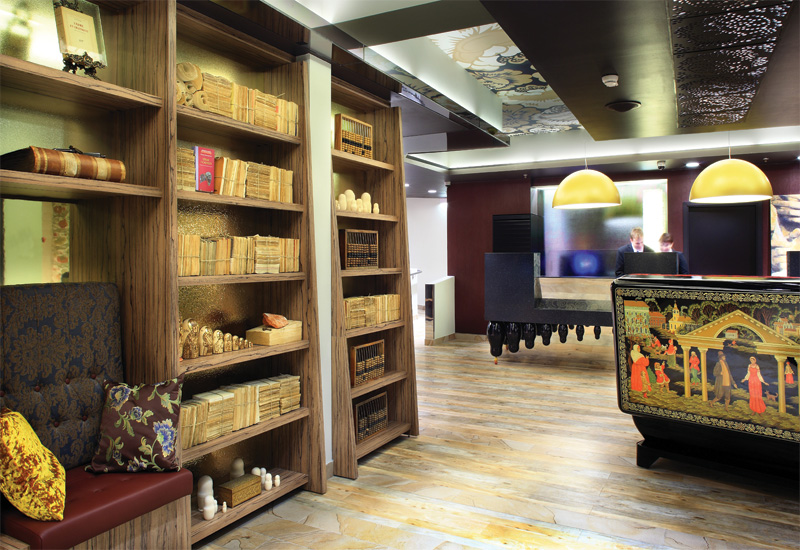 The reception desk, which appears to float on air, is supported by a group of inverted black Matrioshka dolls.
The reception desk, which appears to float on air, is supported by a group of inverted black Matrioshka dolls.
The Radisson Sonya Hotel, St. Petersburg has taken the city’s favourite literary son Dostoyevsky and transformed the design of the property with his renowned novel in mind.
A unique ‘storytelling’ approach to interior design has not only played a major role in making the Radisson Sonya Hotel one of the most popular in St. Petersburg, but has also seen it become a focal point for appreciation of the city’s favourite literary son, the novelist Fyodor Dostoyevsky and his masterpiece, Crime and Punishment — one of the world’s greatest stories.
Swedish interior designers Stylt Trampoli were hired by Norwegian property developer Linstow AS to help make their newly acquired 176-room hotel in St. Petersburg stand out in a market ironically filled with Hilton and Sheraton ‘lookalikes’ and ‘wannabees’.

| Advertisement |
Their first step was to visit St. Petersburg to see what made the city tick. “We were looking for a tourist guide book to the city and a friendly chef told us that the best one was Crime and Punishment!” says Stylt principal, Nissen Johansen.
“As we came to understand, this was a typically Russian comment, as he meant that it was the best guide to the psyche of the people of St. Petersburg.”
He explains that Russians are very proud of the city, which is the nation’s cultural capital, and also of Crime and Punishment — a shocking and gripping story of murder, remorse and ultimate redemption, which some Russians feel is also reflective of their national character.
“We realised that this great novel represented a global brand that could be leveraged to stunning effect in the design and positioning of the hotel.”
But how would they pitch to their, self-confessedly conservative, client the proposal that their hotel should be themed on the story of Rodion Raskolnikoff, who begins by murdering two women - one of them an old lady — and is finally saved from descending into a moral abyss (but not from prison) by Sophia “Sonya” Semenova, a good middle class girl who has been forced into prostitution to save her family from bankruptcy?
To use this apparently dark and negative plot as the basis for designing a hotel — let alone to name it after a prostitute — seemed to go against all the rules of marketing.
And yet after a tense meeting, their client swallowed hard and agreed to take their advice, together with all the commercial risk implied. But they need not have worried, as the hotel’s subsequent success has proven.
Entering the lobby, you feel you are entering Dostoyevsky’s own studio. Book shelves boast no less than 80 copies of Crime and Punishment in different editions and languages, mixed with piles of manuscript paper, as though the great author himself were about to emerge from the bar to resume writing.
The reception desk, which appears to float on air, is supported by a group of inverted black Matrioshka dolls, with a solitary tiny coloured doll at the bottom seeming to bear the weight of the entire structure (just as the saintly Sonya bore the burdens of Raskolnikoff’s tortured life).
Down the corridor in the Metamorfos Restaurant & Bar, more symbolism is at work.
Raskolnikoff’s metamorphosis from a murderer into a good man was largely thanks to the sweet solicitations of his great love Sonya, who despite her enforced profession, typifies many of the qualities of the Virgin Mary.
Dostoyevsky was fascinated with Rafael’s painting called the Sistine Virgin, which he went to see five times at a museum in Dresden. In the Metamorfos outlet, you will see images of the Virgin, morphing first into Dostoyevsky and then changing into Rafael.
Each of the guest room doors features a plaque with a quotation from the novel. The carpets in the room corridors are patterned with further text from the book, while the walls feature photos from specific landmarks in St. Petersburg named in the novel, that Raskolnikoff passed by during his famous feverish walk when he decides to murder the old lady pawn broker, and initiates his spiral into delirium.
Not your typical bland hotel interior by any means; imagine which Middle Eastern stories could be portrayed in this way! So successful has this approach been that it has received an important endorsement from Dostoyevsky’s own great grandson, Dimitri, who is now a regular visitor to the hotel.
A tram driver by trade but an interior designer by training, this warm and bearded figure is often seen chatting with guests about his illustrious forebear, as well as his own fascinating life history. When Nissen-Johansen asked Dimitri how he would have designed the hotel, if he had the chance, he exclaimed that he would have done it “just like this”!








 Search our database of more than 2,700 industry companies
Search our database of more than 2,700 industry companies









